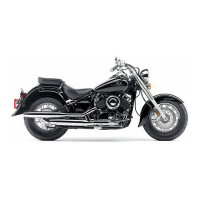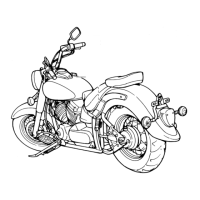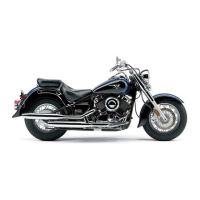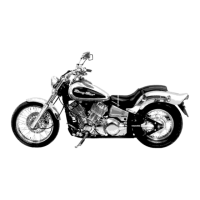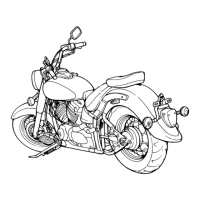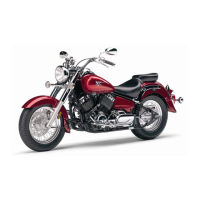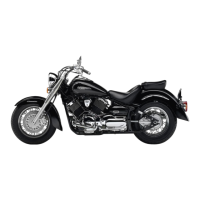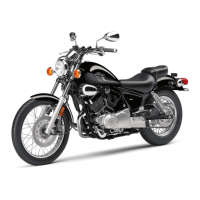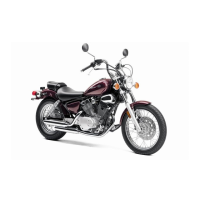Do you have a question about the Yamaha V-star XVS65V and is the answer not in the manual?
Explains how safety and important information is distinguished in the manual.
Essential guidelines for safe motorcycle operation and awareness.
Importance of protective gear and risks of unauthorized vehicle modifications.
Guidelines for safely adding cargo and accessories to the motorcycle.
Precautions regarding fuel handling, exhaust fumes, and safe parking.
Identifies the location and importance of various vehicle labels.
Identifies key components visible from the left side of the motorcycle.
Identifies key components visible from the right side of the motorcycle.
Overview of the motorcycle's controls, instruments, and gauges.
Explains the function and operation of the main switch and steering lock.
Describes the function of various indicator and warning lights on the dashboard.
Details the operation of switches located on the left and right handlebars.
Explains the operation of the clutch lever and shift pedals for gear changes.
Covers the front brake lever, rear brake pedal, and fuel tank cap operation.
Information on fuel, catalytic converter, fuel cock, and starter knob.
Instructions for removing/installing seats, using the helmet holder, and accessing storage.
Details on sidestand operation and the ignition circuit cut-off system.
A comprehensive list of items to check before each ride for safe operation.
Procedures for starting and warming up both cold and warm engines.
Guidance on proper gear shifting techniques for acceleration.
Critical instructions for the engine break-in period to ensure longevity.
Safe practices for parking the motorcycle, including hot engine precautions.
Scheduled maintenance tasks for the emission control system and general upkeep.
Guidance on checking and replacing spark plugs for engine health.
Procedures for checking engine oil level and replacing the oil filter element.
Instructions for cleaning the air filter element to maintain engine performance.
Information on tire pressure, inspection, specifications, and spoke wheel care.
Procedures for adjusting brake levers, pedals, and checking brake fluid.
Information on battery maintenance, charging, and replacing fuses.
Step-by-step instructions for removing and installing front and rear wheels.
A guide to diagnosing and resolving common operational problems.
Proper methods for cleaning the motorcycle and protecting it from corrosion.
Procedures for storing the motorcycle to maintain its condition long-term.
Detailed dimensions, weight, and wheelbase specifications for various models.
Technical data on engine type, displacement, fuel, and spark plugs.
Specifications for chassis, tires, wheels, and brake systems.
Technical details on the electrical system, including battery and fuse ratings.
Recording key, vehicle, and model identification numbers for parts ordering.
Procedure for reporting potential safety defects to NHTSA and Yamaha.
Details of the limited warranty coverage provided by Yamaha.
Information on optional extended service plans for continued protection.
Explains how safety and important information is distinguished in the manual.
Essential guidelines for safe motorcycle operation and awareness.
Importance of protective gear and risks of unauthorized vehicle modifications.
Guidelines for safely adding cargo and accessories to the motorcycle.
Precautions regarding fuel handling, exhaust fumes, and safe parking.
Identifies the location and importance of various vehicle labels.
Identifies key components visible from the left side of the motorcycle.
Identifies key components visible from the right side of the motorcycle.
Overview of the motorcycle's controls, instruments, and gauges.
Explains the function and operation of the main switch and steering lock.
Describes the function of various indicator and warning lights on the dashboard.
Details the operation of switches located on the left and right handlebars.
Explains the operation of the clutch lever and shift pedals for gear changes.
Covers the front brake lever, rear brake pedal, and fuel tank cap operation.
Information on fuel, catalytic converter, fuel cock, and starter knob.
Instructions for removing/installing seats, using the helmet holder, and accessing storage.
Details on sidestand operation and the ignition circuit cut-off system.
A comprehensive list of items to check before each ride for safe operation.
Procedures for starting and warming up both cold and warm engines.
Guidance on proper gear shifting techniques for acceleration.
Critical instructions for the engine break-in period to ensure longevity.
Safe practices for parking the motorcycle, including hot engine precautions.
Scheduled maintenance tasks for the emission control system and general upkeep.
Guidance on checking and replacing spark plugs for engine health.
Procedures for checking engine oil level and replacing the oil filter element.
Instructions for cleaning the air filter element to maintain engine performance.
Information on tire pressure, inspection, specifications, and spoke wheel care.
Procedures for adjusting brake levers, pedals, and checking brake fluid.
Information on battery maintenance, charging, and replacing fuses.
Step-by-step instructions for removing and installing front and rear wheels.
A guide to diagnosing and resolving common operational problems.
Proper methods for cleaning the motorcycle and protecting it from corrosion.
Procedures for storing the motorcycle to maintain its condition long-term.
Detailed dimensions, weight, and wheelbase specifications for various models.
Technical data on engine type, displacement, fuel, and spark plugs.
Specifications for chassis, tires, wheels, and brake systems.
Technical details on the electrical system, including battery and fuse ratings.
Recording key, vehicle, and model identification numbers for parts ordering.
Procedure for reporting potential safety defects to NHTSA and Yamaha.
Details of the limited warranty coverage provided by Yamaha.
Information on optional extended service plans for continued protection.
| Manufacturer | Yamaha |
|---|---|
| Model | V-star XVS65V |
| Category | Cruiser |
| Displacement | 649 cc |
| Bore x Stroke | 81.0 mm x 63.0 mm |
| Compression Ratio | 9.0:1 |
| Ignition | TCI |
| Transmission | 5-speed |
| Final Drive | Shaft |
| Front Suspension | Telescopic fork |
| Rear Suspension | Swingarm |
| Front Brake | Single disc |
| Rear Brake | Drum |
| Front Tire | 130/90-16 |
| Rear Tire | 170/80-15 |
| Engine Type | Air-cooled, SOHC, V-twin |
| Fuel Capacity | 16 l (4.2 US gal) |
| Ground Clearance | 140 mm (5.5 inches) |

